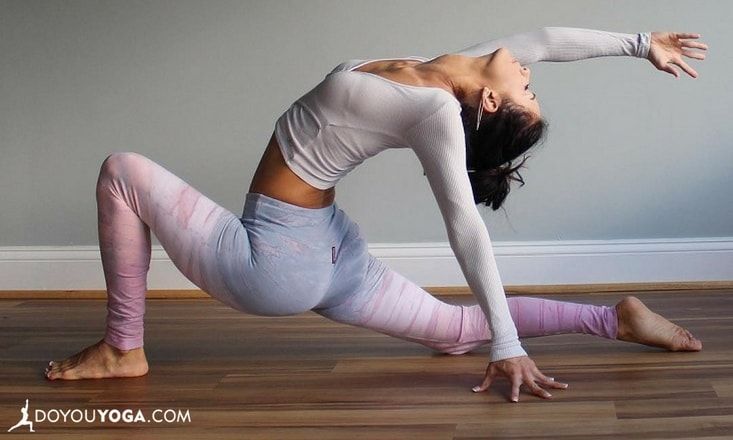As yoga teachers, we know the power of the ancient philosophy of yoga to transform lives. We have experienced that yoga is so much deeper than just posing. Asana, however, can be a powerful gateway into this depth of the practice. For this reason, I think it is vital that we teach asana entrenched with the philosophy.
The Yamas and Niyamas are a valuable ethical code for good-living as a yogi. The Yamas focus on the top 5 things “not to do” and are explored in my article: “For Teachers: How to Teach the Yamas in Class.” The Niyamas focus on a list of 5 things “to do” in order to live a good life. Let’s explore these concepts, and practical applications and cues you can use while teaching asana classes.
Santosha: Contentment
A feeling of contentment is like a muscle that needs to be strengthened and stretched through repetitions like journaling, prayer, or affirmations. As a yoga therapist, I encourage my clients to practice this constantly—in asana and in life.
Cues to consider:
- “Find contentment with where you are in the pose right now. There is nowhere else to be. There is nothing else to do.”
- “It is not about doing the poses perfectly; it is about being perfectly okay with who you are, in your body, in this moment.”
Saucha: Cleanliness
For the type of therapeutic classes I have taught through the years (which includes retirement communities and populations dealing with chronic pain), cleanliness is very important for safety. Preventing falls is a big deal in such special needs classes.
However, regardless of the group you are teaching, both you and your students will likely feel more at peace with less clutter and more cleanliness in the room. This intentionality in asana class can spill over to intentional cleanliness and organization in life.
Cues to consider:
- “Make sure your props and area are clean and tidy. Avoiding clutter is good for your mind and it also makes the room safer to prevent anyone from tripping and falling.”
- At the end of class: “As we end class, allow the time putting away the props and cleansing your mat to be meditative.”
Tapas: Self-Discipline
Tapas or self-discipline is a fiery, burning desire to improve. We all know that this yoga stuff works like magic. However, there is a secret to the magic: you have to actually do it! Having the discipline to come to yoga class or to do a home practice is key.
I also encourage my students to do the best they can while in class to get the maximum benefit. (Although, a balance between this self-discipline/tapas and no harm/ahimsa of not pushing too far.)
Cues to consider:
In a strong pose held for a longer period of time, like Warrior II or Chair pose, consider using it as a reflection of self-discipline like this: “Feel the sensations and vibrations building. Breathe through it with a sense of discipline…Feel the strength of your legs supporting you…A few more deep breaths; of course, come out of this as you need, but what is it like to breathe through a challenge? Is there a challenge you are dealing with in life right now that you can envision breathing through? You’ve got it…3 more deep breaths…and release. Shake it out and let go!”
Svadhyaya: Self-Study
Many teachers read a quote from a text that inspires them, as part of sharing their own self-study practice. I’ll share with you my favorite quotes to read in an asana class.
Cues to consider:
- “The breath is a wonder drug.” -Desikachar
- “There is a vitality, a life force, an energy, a quickening that is translated through you into action, and because there is only one of you in all of time, this expression is unique. And if you block it, it will never exist through any other medium and it will be lost. The world will not have it. It is not your business to determine how good it is nor how valuable nor how it compares with other expressions. It is your business to keep it yours clearly and directly, to keep the channel open.” -Martha Graham
Ishvara Pranidhana: Surrendering
Feeling a sense of surrender in the physical body during asanas can really translate into letting go emotionally and in our lives. Restorative and Yin yoga, and yoga nidra, create a space conducive to cultivating the principle of ishvarapranidhana.
Cues to consider:
- In Savasana or a restorative pose: “With each exhale, feel your body releasing more into the surface supporting you. Feel a sense of surrender as your body relaxes down.”
- “Surrender to that which you cannot change or control. Surrender to this moment–accepting every single nuance of the moment…the sounds….sensations in your body…the rhythm of your natural breath…the thoughts that arise. In this moment, you are exactly where you need to be…doing exactly what you need to do. You are perfectly whole and nothing needs to be fixed.”
Yoga is powerful. I am constantly challenged to grow as I discover deeper layers of depth of our tradition in my studies and meditation. We have such unique roles as yoga teachers—the more we can teach from the rich philosophy of yoga, the more lives can be transformed.
Image credit: Odette Hughes


